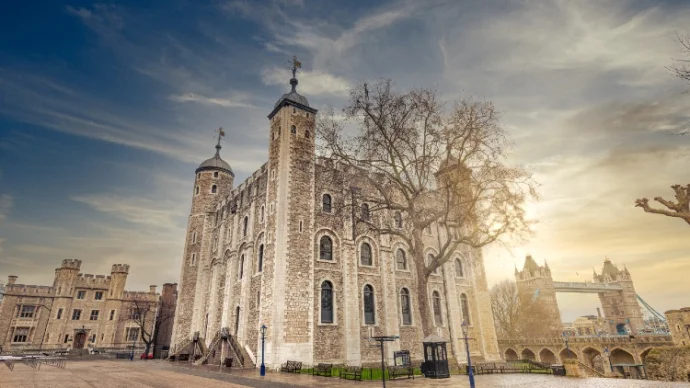
About The Great Fire of London Monument
The Great Fire of London Monument, often known simply as “The Monument” is a Doric column designed by Sir Christopher Wren, situated near the northern end of London Bridge. It was built between 1671 and 1677 to commemorate the Great Fire of London and to celebrate the rebuilding of the City, and is Grade I-listed.
History of The Great Fire of London Monument
The Great Fire of London was a major fire which began on 2 September 1666 and wasn’t extinguished until 5 September. What started as a blaze in Farynor’s bakery in Pudding Lane soon engulfed much of the city, destroying thousands of buildings, from private homes to public monuments, including parts of St Paul’s Cathedral.
 Listen Now
Listen NowAs part of the rebuilding of London, it was decided to erect a permanent memorial of the Great Fire near the place where it began. (The Monument itself is built on the site of St Margaret, New Fish Street, the first church to be destroyed by the Great Fire).
Sir Christopher Wren, Surveyor General to King Charles II and the architect of St. Paul’s Cathedral, and his friend and colleague, Dr Robert Hooke, drew up plans for a Doric column made of Portland Stone containing a cantilevered stone staircase of 311 steps leading to a viewing platform. On top, the column was crowned with a drum and a copper urn vase of flames, symbolising the Great Fire.
The height of The Monument is 202 feet (61 metres high) – representing the exact distance between the Great Fire of London Monument and the place where the fire began in Pudding Lane.
The column was built between 1671 and 1677 – taking 6 years due to the difficulty of getting a sufficient quantity of Portland stone of the required dimensions. Whilst initially used for experiments by the Royal Society, it soon became purely a place of historic interest.
The Monument has undergone frequent repair and redecoration, with its urn re-gilded periodically. In May 1834 it was completely renovated, and it was closed to visitors during World War Two. Pudding Lane escaped serious damage during the war, as did the Monument itself, though it did receive superficial damage from bomb fragments which scarred the base. The Monument was reopened to the public on 13 August 1945, and was steam-cleaned in 1954 with its bomb scars removed.
The Great Fire of London Monument today
The area around the base of the column, Monument Street, was pedestrianised in 2006, and The Monument itself closed in July 2007 for an 18-month, £4.5 million refurbishment project. During the 2007–2009 refurbishment, a 360-degree panoramic camera was installed on top of the Monument. It is updated every minute and runs 24 hours a day, providing a record of weather, building and ground activity in the City.
The Monument continues to attract over 150,000 visitors each year, who can climb its 311 spiral steps to the public viewing platform (there are an additional 34 steps that go right to the very top).
Getting to The Great Fire of London Monument
The Monument stands at the junction of Monument Street and Fish Street Hill in the City of London, just 61 metres from where the Great Fire of London started.
As with getting to all sites in London, public transport is advised. The nearest rail stations are Fenchurch Street, Cannon Street, Tower Gateway DLR stations, or London Bridge where the monument is just a short walk over the River Thames with striking views of Tower Bridge to the east. The nearest tube stations are either Monument (District and Circle lines) or London Bridge (Northern and Jubilee lines).
Local bus routes near the Monument all go through London Bridge, and include numbers 17, 21, 35, 40, 47, 48, 133, 141, 149, 344 and 521. The nearest car park is NCP Thames Exchange (Vintry), located on Bell Wharf Lane off Upper Thames Street.
Featured In

London Historic Sites
Londinium, The Big Smoke, The Great Wen: London has experienced its fair share of change over its 2000-year history. Here's our pick of some of the British capital's most famous historic sites to visit today.




















